|
Posted: 6/22/2017 1:28:22 PM EDT
I have been reading WV0H's blog where logs all of his various antenna projects: https://wv0h.blogspot.com/
He goes into a lot of detail about inherent/internal losses of various antenna designs, coax, 9:1 ununs, etc. and it really opened up my eyes to really how much power I'm probably losing in my portable antenna systems. If I'm lucky I'm probably getting 50-75% of my transmit power actually radiated into the ether with my current portable antenna systems, and considerably less when I tune away from their resonant bands. When you're only starting with 5-10 watts in a portable scenario that loss can be a killer. Granted, while my current systems are probably very lossy, I've had a lot of success with them. I've WAS SSB QRP with nothing more than an FT-817 and combination of LNR 10/20/40, and an Alexloop. That just to say, don't disregard an antenna system based on loss numbers alone. However, what this has shown me is it would behoove me if I were to try and utilize portable antennas that can help my little QRP signal, and not take away from it. WV0H talks about his 88ft "Park Portable Doublet" and it's ~7db of gain on 20m. That would take my 10 watts from the KX2 and make it sound like 50 watts...my odds of making reliable contacts just got considerably higher. Couple that antenna gain with an efficient mode like CW or Olivia, and now you're really getting somewhere! Granted, if I'm up on a peak or something, the logistics of setting up a perfect 88ft doublet are just not practical and I'm better off using something more compact and more lossy, but I need to start being smart and taking advantage of more efficient antennas when it is reasonable to set them up and use them. 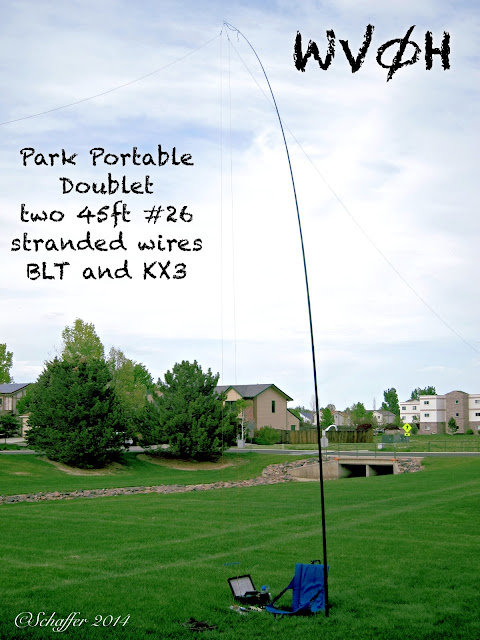
|
|
|
|
That's awesome! I kind of got lost in his web page--too many links in train of thought order. What is he currently using to tune/match that?
|
|
|
|
|
|
|
|
The problem with claiming gain from a dipole, is you have that much gain in what direction? You only get gain by taking signal from some direction and concentrating it in another direction. So in the case of a long-for-wavelength dipole, you have an X shaped pattern with gain in certain directions but serious negative gain/nulls in other directions. So that may be good or may be bad depending on the exact orientation of your antenna to whoever you are trying to contact.
I agree with the downsides of lossy matching systems etc for most of the portable antennas that are all the rage now. I would suggest instead of being sucked in by a claim of gain by a long dipole, that a simple 1/2 wave dipole (1/4 wave on each side) will be a better option for a smooth null-free pattern. |
|
|
|
I am by no means super knowledgeable in this area, but according to his plots the Park Portable Doublet @ 30ft has a pretty clean broadside pattern which would be easy to orient in the direction of interest. Images and full write-up can be found here: https://wv0h.blogspot.com/2016/01/the-park-portable-doublet-system_22.html
20m and 40m |
|
|
|
Yup. Ive been saying this for years. Dipole is where its at. Doublet is just a variation on it. Endfed wires are second choice. Last choice is verticals.
You can get even more gain oit of wires but its also very directional and harder to setup. |
|
|
|
|
|
everything is a compromise.
compromise convenience or compromise signal. it all depends on location. |
|
|
|
Not sure where this idea that verticals are the last choice comes from.
In fact for the low bands, where one can't get a horizontal antenna up hgh enough, verticals and inverted-L's are the FIRST choice for low angle DX radiation. "Verticals and Inverted-Ls for the Low Bands – Horizontal Antennas for High Bands" ===> http://vtenn.com/Blog/?p=221 Here's why - we get stronger radiation at low angles with vertical polarization, Note that it takes a dipole up at around 40 or 45 ft to beat a simple vertical for low angle DX ===> 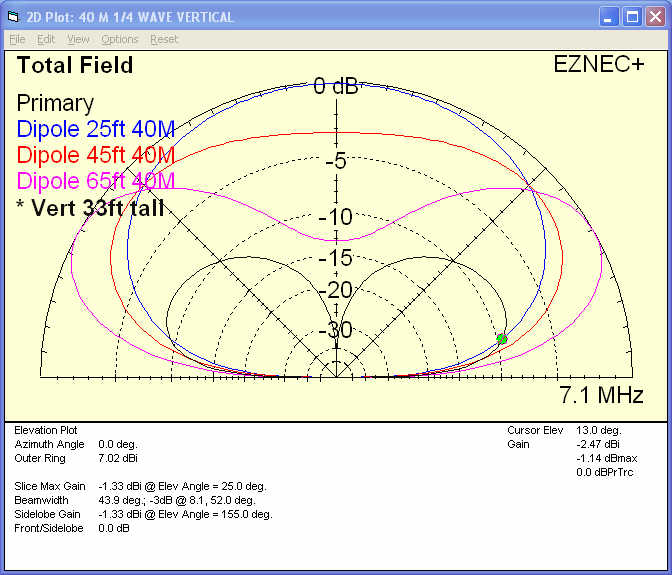
|
|
|
|
There's a lot of interesting info on the WV0H website, but also some not quite accurate stuff, or info that is misinterpreted. For example, it would also be a mistake to come away with the idea that (properly designed) Ununs shouldn't be used because they're lossy.
On some of the junk websites, like half of the stuff on hamuniverse, that may be true, since one finds very few actual measured and characterized "designs" there. Here's an example of a simple design for a Base Matching Unit for 45-ish ft verts and inverted-L's: "80 Meters and Up – Portable Base Matching Unit for 42 to 48 Foot Verticals and Inverted-Ls – Medium Power Version" ===> http://vtenn.com/Blog/?p=1570 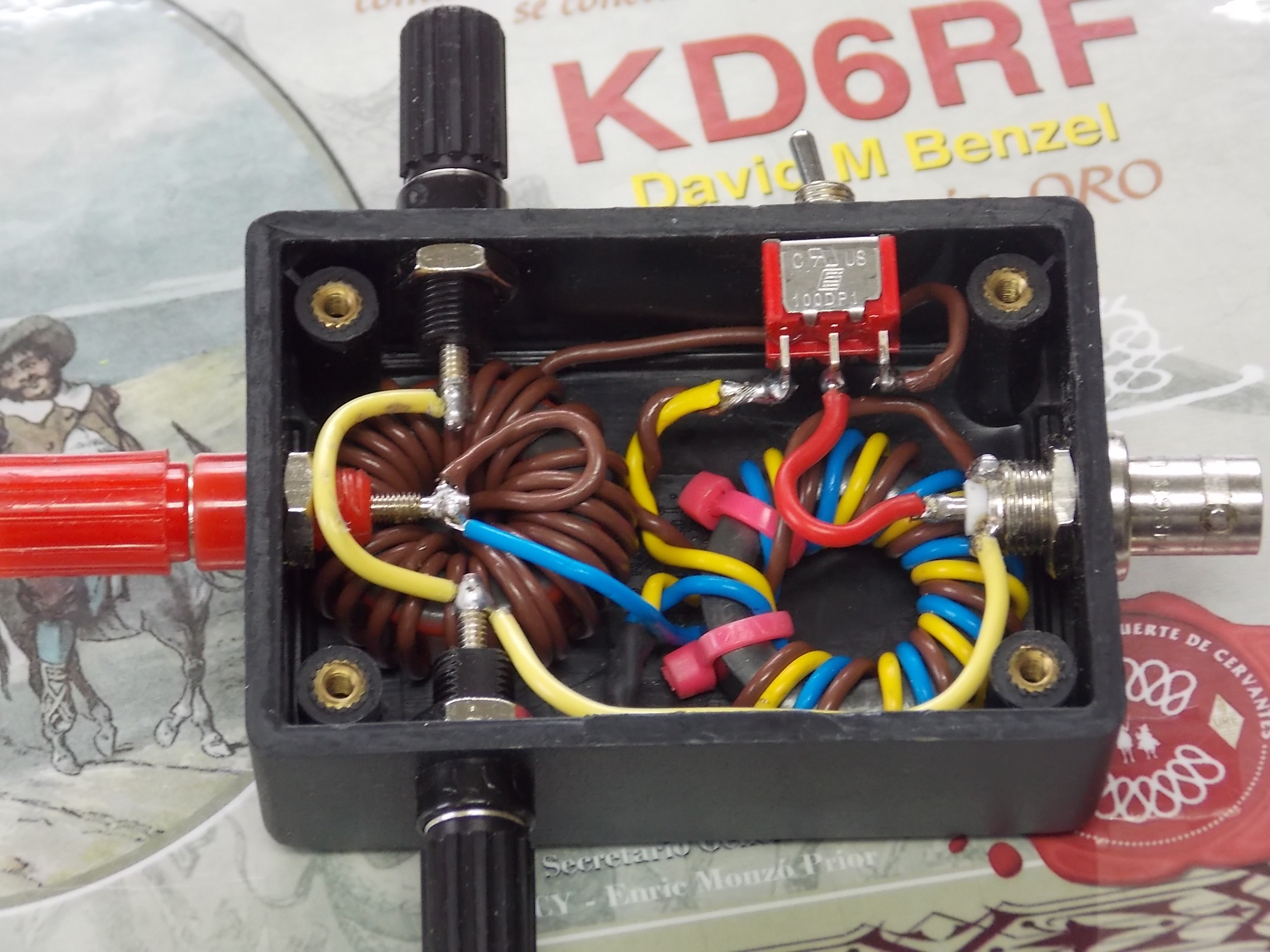
This simple design has 1 dB or lower loss on all HF bands. The entire PURPOSE of this Unun is to LOWER loss on the feedline and/or in the tuner for the case where one wishes to use an in-shack tuner or for some narrow-range Auto Tuners that can't quite hit a match on some of the impedance extremes of non-resonant antennas. By FAAARRRR the biggest and most common loss seen in most of the systems out there are GROUND losses for all of those so-called "end-feds" that don't use proper radial fields, especially on the low bands. It's easy to find systems out there with an easy 10 of 15 dB of loss on 40 M, for example, simply because the crummy web article or unknowledgeable marketer invokes the words "end-fed" like a magic incantation, and ignores proper radial system design. Second most common "loss" would be that lost by using a low mounted horizontal antenna and expecting good DX performance. There are a dozen complaints on the various sites every day from someone who can't understand why their worm-and-cloud-warming, non-radialed end-fed" contraption doesn't make any DX or longer range contacts. "But my SWR is really sweet ! and is 1:1 across all of the bands!!! And, oh ya, my powdered iron hamuniverse Unun is getting hot when I tune up my 817...." |
|
|
|
Quoted:
Not sure where this idea that verticals are the last choice comes from. In fact for the low bands, where one can't get a horizontal antenna up hgh enough, verticals and inverted-L's are the FIRST choice for low angle DX radiation. "Verticals and Inverted-Ls for the Low Bands – Horizontal Antennas for High Bands" ===> http://vtenn.com/Blog/?p=221 Here's why - we get stronger radiation at low angles with vertical polarization, Note that it takes a dipole up at around 40 or 45 ft to beat a simple vertical for low angle DX ===> http://vtenn.com/Blog/wp-content/uploads/2016/12/40M_Dipole_vs_40M_Vertical.jpg View Quote Otherwise I Agree that verticals on lower bands, or inverted L-'s are a good call. And actually for portable work an inverted L isn't a decent antenna on lower bands. Then again, the lowest band I tend to work portable is 40m. And once in a while 60/80 for NVIS, which means I don't want the antenna too tall anyway. |
|
|
|
Quoted:
There's a lot of interesting info on the WV0H website, but also some not quite accurate stuff, or info that is misinterpreted. For example, it would also be a mistake to come away with the idea that (properly designed) Ununs shouldn't be used because they're lossy. On some of the junk websites, like half of the stuff on hamuniverse, that may be true, since one finds very few actual measured and characterized "designs" there. Here's an example of a simple design for a Base Matching Unit for 45-ish ft verts and inverted-L's: "80 Meters and Up – Portable Base Matching Unit for 42 to 48 Foot Verticals and Inverted-Ls – Medium Power Version" ===> http://vtenn.com/Blog/?p=1570 http://vtenn.com/Blog/wp-content/uploads/2017/03/BMU-Bottom-View-Med-Pwr.jpg This simple design has 1 dB or lower loss on all HF bands. The entire PURPOSE of this Unun is to LOWER loss on the feedline and/or in the tuner for the case where one wishes to use an in-shack tuner or for some narrow-range Auto Tuners that can't quite hit a match on some of the impedance extremes of non-resonant antennas. By FAAARRRR the biggest and most common loss seen in most of the systems out there are GROUND losses for all of those so-called "end-feds" that don't use proper radial fields, especially on the low bands. It's easy to find systems out there with an easy 10 of 15 dB of loss on 40 M, for example, simply because the crummy web article or unknowledgeable marketer invokes the words "end-fed" like a magic incantation, and ignores proper radial system design. Second most common "loss" would be that lost by using a low mounted horizontal antenna and expecting good DX performance. There are a dozen complaints on the various sites every day from someone who can't understand why their worm-and-cloud-warming, non-radialed end-fed" contraption doesn't make any DX or longer range contacts. "But my SWR is really sweet ! and is 1:1 across all of the bands!!! And, oh ya, my powdered iron hamuniverse Unun is getting hot when I tune up my 817...." View Quote |
|
|
|
Quoted:
And then there's antenna height itself to consider... http://4.bp.blogspot.com/-VdJGfpR_s5A/UoLTNGHrL_I/AAAAAAAAAcg/gayVJJijrn4/s1600/40m_height_comparison_10deg.png Even if you manage to hoist your portable dipole 30 feet in the air, you're still many dB short of the antenna's ultimate potential. View Quote And really if I were trying to work QRP DX, I'd find be a big empty space a few large spools of wire and some terminating resistors and build either an absurdly long beverage or V-beam/rhombic antenna for a bit more gain at really low radiation angles. Yagi like gains, extremely low take of angles. The only thing that sucks is putting them up. |
|
|
|
Quoted:
The Key word is PORTABLE verticals. show me that same graph on 80 or 160 meters for a 10ft vertical, with no radials, or radials that are too short. Otherwise I Agree that verticals on lower bands, or inverted L-'s are a good call. And actually for portable work an inverted L isn't a decent antenna on lower bands. Then again, the lowest band I tend to work portable is 40m. And once in a while 60/80 for NVIS, which means I don't want the antenna too tall anyway. View Quote Again, note how this modest Inverted-L performs much better than low horizontal antennas. .... 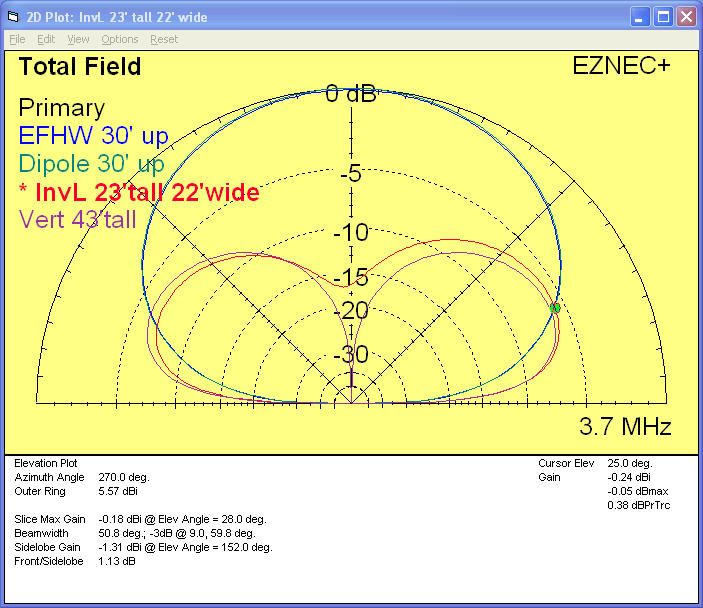
I guess it depends upon what you call "portable" - i not nearly as ambitious as some of you hard-core portable ops guys  , but the system I use out in the "back 40" is on 4 of those cool Sota "Baterangs". 45 ft radiator, and 3 x 2 sets of 45 ft radials. As you can see, I use the BMU / Unun referenced above, and a somewhat large homebrew T-Tuner. , but the system I use out in the "back 40" is on 4 of those cool Sota "Baterangs". 45 ft radiator, and 3 x 2 sets of 45 ft radials. As you can see, I use the BMU / Unun referenced above, and a somewhat large homebrew T-Tuner.
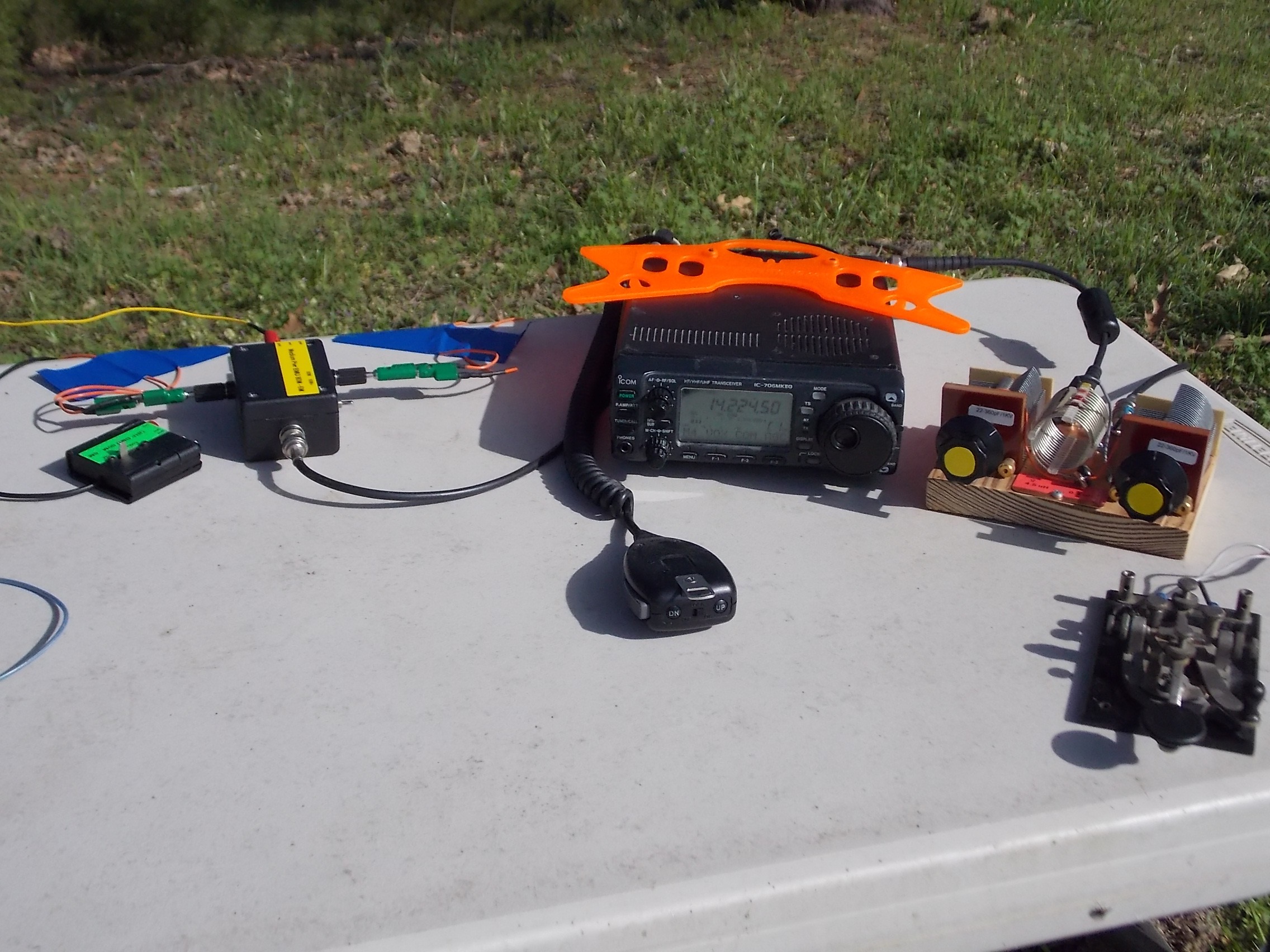
Of course, it helps to have trees for wire antennas 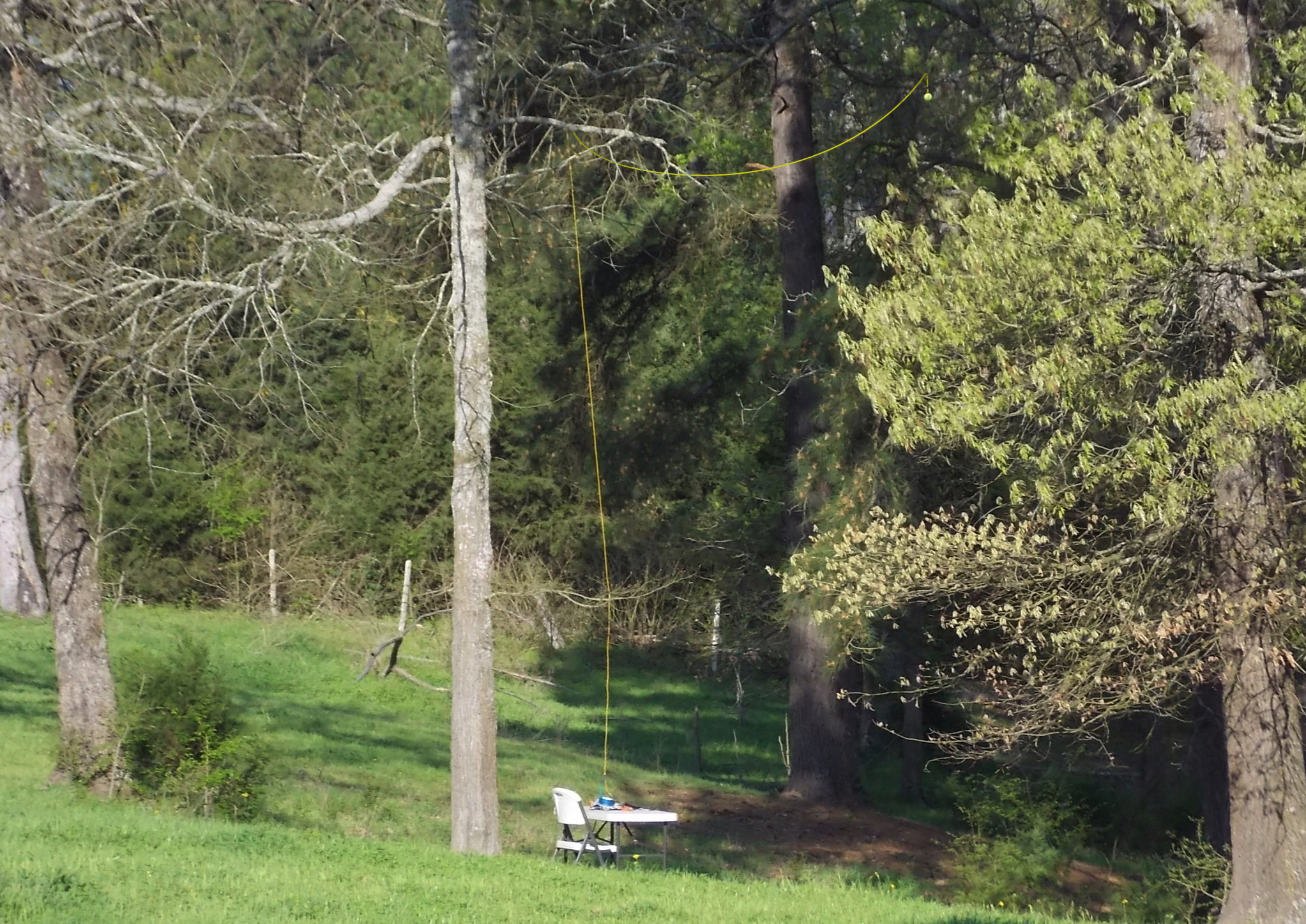
The point is not that I am pimping a one-size-fits-all solution. It's that with a bit of attention to detail, including appropriate polarization, and use of actual designs (as opposed to magic-end-fed hamuniverse crap), it's possible to pack in a fully capable 80 m DX-worthy system. Making 40 M a picee of cake |
|
|
|
My original point of the topic was not to sing the praises nor shame any particular antenna. I just happened to use that doublet as an example because he had examples and lots of data from it. It was more of a "Hey guys, I've been using crappy antennas, in equally crappy configurations, and now that I've come to that realization I should probably put a little more effort into using more better antennas and try a little harder to get them more higher up and then hopefully I won't suck so bad at this radio stuff...."
|
|
|
|
Quoted:
In the same article "Verticals and Inverted-Ls for the Low Bands – Horizontal Antennas for High Bands" ===> http://vtenn.com/Blog/?p=221 , the last plot is for a 23 ft tall x 22 ft wide Inverted-L on 80 M Again, note how this modest Inverted-L performs much better than low horizontal antennas. .... http://vtenn.com/Blog/wp-content/uploads/2016/12/FIG-0-2-InvL-vs-Vert-vs-EFHW-vs-Dipole.jpg I guess it depends upon what you call "portable" - i not nearly as ambitious as some of you hard-core portable ops guys  , but the system I use out in the "back 40" is on 4 of those cool Sota "Baterangs". 45 ft radiator, and 3 x 2 sets of 45 ft radials. As you can see, I use the BMU / Unun referenced above, and a somewhat large homebrew T-Tuner. , but the system I use out in the "back 40" is on 4 of those cool Sota "Baterangs". 45 ft radiator, and 3 x 2 sets of 45 ft radials. As you can see, I use the BMU / Unun referenced above, and a somewhat large homebrew T-Tuner.
http://vtenn.com/Blog/wp-content/uploads/2016/03/FIGURE-28-Portable-Zoom-Medium-Power-1-.jpg Of course, it helps to have trees for wire antennas http://vtenn.com/Blog/wp-content/uploads/2016/03/FIGURE-2-45-Foot-Inverted-L-Portable-Up-In-The-Trees-3.jpg The point is not that I am pimping a one-size-fits-all solution. It's that with a bit of attention to detail, including appropriate polarization, and use of actual designs (as opposed to magic-end-fed hamuniverse crap), it's possible to pack in a fully capable 80 m DX-worthy system. Making 40 M a picee of cake View Quote And actually I use slanted dipoles or V dipoles more than end-feds if I I only have one support, since they are more efficient. About the only end fed I use is the EFZ-Trail friendly, and thats only if I don't have the time to put up something better, but when I have ~30 minutes to play, antenna erection time gets to be a critical factor. |
|
|
|
Quoted:
My original point of the topic was not to sing the praises nor shame any particular antenna. I just happened to use that doublet as an example because he had examples and lots of data from it. It was more of a "Hey guys, I've been using crappy antennas, in equally crappy configurations, and now that I've come to that realization I should probably put a little more effort into using more better antennas and try a little harder to get them more higher up and then hopefully I won't suck so bad at this radio stuff...." View Quote I've thought of making something like the nor-cal doublet as its called, but I just never got around to it. |
|
|
|
OT: but in regards to the Norcal Doublet. Everyone always bemoans the feedline loss you get with a basic speaker wire doublet. Do you think you have less loss using that 4 conductor ribbon cable because of the greater spacing of the wires? Or do the 2 inactive wires in the middle just couple to the active wires and make it the same?
Also OT: My first HF contact was made using an FT-817 and a speaker wire doublet cut for 20m. I had about 10ft of feedline, and had the two legs tied between to pine trees at a height of about 8ft, and this was down in the bottom of a valley in the mountains. I was hooked after that... |
|
|
|
I've been researching for a good lightweight portable antenna like the SotaBeams and similar stuff. I have made contact with lots of stations running SotaBeams on QRP and they seem to make it work well.
The idea of using a wire without matching transformer is intriguing - less loss and all that. The research continues. I will disagree about the post RE: verticals. They definitely fill a need. While I haven't been doing the radio thing very long, I researched for months deciding on an antenna for our office building roof before getting the AV-680 and so far I have been pleased as punch with it. So far I have been able to work quite a bit of SSB DX with it to Europe, South America, and Asia and haven't had stations I could hear but not work fairly easily on 100W including many IOTA DXpeditions running a wire barefoot. It gets through pileups well. A couple of days ago I turned the radio on in the afternoon and heard a station with a good pileup going and told my coworker I bet i can get in on the first call. Well, it was the second call but no big deal. I like the convenience of band hopping without changing anything except the radio. When I finally get some decent coax it will be even better. I'm using crap RG58 and giving up 66% of my power on 20M but it's all I had laying around. |
|
|
|
Quoted:
Like I said, for portable work, a dipole is hard to beat provided you can get it setup. Its got decent gain, some directivity and goes up relatively quick, and if you make your own using 26ga stealth wire its also lightweight and cheap View Quote If the goal is DX, then it's easy to beat a low dipole on 80 M and 40 M, perhaps 30 M, with 45 / 23 ft verticals or Inverted-L's receptively. Plus 4 or 6 or so equal length radials. On those lower bands, it's impossible to NOT beat a low horizontal antenna for DX with a Vertical or Inverted-L of less than half the length of a dipole (plus radials, of course However, if your goal is NVIS or more near-in work, then you're golden with a low dipole.........There'd be no reason to mess with the additional stuff required for DX-worthy verts or inverted-L's. For absolute minimal carry-in stuff - there's no question that the above praised non-resonant verticals and Inverted-L's mean a bit more stuff to carry in than a minimalist dipole. But if DX is the goal, then that's the price In either case, the original point is a good one - check the details and make sure the components used don't add too much loss. The point that I'm adding is to also be aware of the correct polarization choice for the goal of your comms - vert for DX on the low bands, horizontal for the higher bands. Ya, that. And that mistake-riddled hamuniverse is not a good place to go for reliable info |
|
|
|
Quoted:
Well, that's the question - hard to beat for what purpose? If the goal is DX, then it's easy to beat a low dipole on 80 M and 40 M, perhaps 30 M, with 45 / 23 ft verticals or Inverted-L's receptively. Plus 4 or 6 or so equal length radials. On those lower bands, it's impossible to NOT beat a low horizontal antenna for DX with a Vertical or Inverted-L of less than half the length of a dipole (plus radials, of course However, if your goal is NVIS or more near-in work, then you're golden with a low dipole.........There'd be no reason to mess with the additional stuff required for DX-worthy verts or inverted-L's. For absolute minimal carry-in stuff - there's no question that the above praised non-resonant verticals and Inverted-L's mean a bit more stuff to carry in than a minimalist dipole. But if DX is the goal, then that's the price In either case, the original point is a good one - check the details and make sure the components used don't add too much loss. The point that I'm adding is to also be aware of the correct polarization choice for the goal of your comms - vert for DX on the low bands, horizontal for the higher bands. Ya, that. And that mistake-riddled hamuniverse is not a good place to go for reliable info View Quote Honestly QRP DX is doable IMO, but it takes alot of effort under current conditions, so I've mainly given up on it. Back a few years ago I was working the world on 10m with a frikkin AT271 fishingpole and 20W of power. These days, I'm using dipoles on 20M and 50W of power and getting poor results working CONUS... Thems the breaks... You never did answer my question about your endfed setup, with regards to how its fed and if there are radials and what length they are? |
|
|
|
Quoted:
I've been researching for a good lightweight portable antenna like the SotaBeams and similar stuff. I have made contact with lots of stations running SotaBeams on QRP and they seem to make it work well. The idea of using a wire without matching transformer is intriguing - less loss and all that. The research continues. I will disagree about the post RE: verticals. They definitely fill a need. While I haven't been doing the radio thing very long, I researched for months deciding on an antenna for our office building roof before getting the AV-680 and so far I have been pleased as punch with it. So far I have been able to work quite a bit of SSB DX with it to Europe, South America, and Asia and haven't had stations I could hear but not work fairly easily on 100W including many IOTA DXpeditions running a wire barefoot. It gets through pileups well. A couple of days ago I turned the radio on in the afternoon and heard a station with a good pileup going and told my coworker I bet i can get in on the first call. Well, it was the second call but no big deal. I like the convenience of band hopping without changing anything except the radio. When I finally get some decent coax it will be even better. I'm using crap RG58 and giving up 66% of my power on 20M but it's all I had laying around. View Quote |
|
|
|
Quoted:
OT: but in regards to the Norcal Doublet. Everyone always bemoans the feedline loss you get with a basic speaker wire doublet. Do you think you have less loss using that 4 conductor ribbon cable because of the greater spacing of the wires? Or do the 2 inactive wires in the middle just couple to the active wires and make it the same? Also OT: My first HF contact was made using an FT-817 and a speaker wire doublet cut for 20m. I had about 10ft of feedline, and had the two legs tied between to pine trees at a height of about 8ft, and this was down in the bottom of a valley in the mountains. I was hooked after that... View Quote Where can I find cheap 4 conductor ribbon cable BTW? And that is a fun story. For all the crap I give people running verticals I randomly setup a buddistick on the deck a few days ago and made 1 fluke SSB contact a few states away with it. I'm sure the other end had some sort of phased array to pick me up tho, as I spent another hour trying to make contacts after that one with no one hearing me. |
|
|
|
|
|
Quoted:
I agree, but if we go back to the OP's main point, PORTABLE antennas, in my mind that means something I carry in a pack. A "mobile" antenna is something I can haul in a car. Different strokes for different folks. You never did answer my question about your endfed setup, with regards to how its fed and if there are radials and what length they are? View Quote 80 Meters through 6 Meters. Here it is again, but this time showing the QRP version with homebrew CW transceivers, Base Matching Unit, and QRP Tuner ===> 
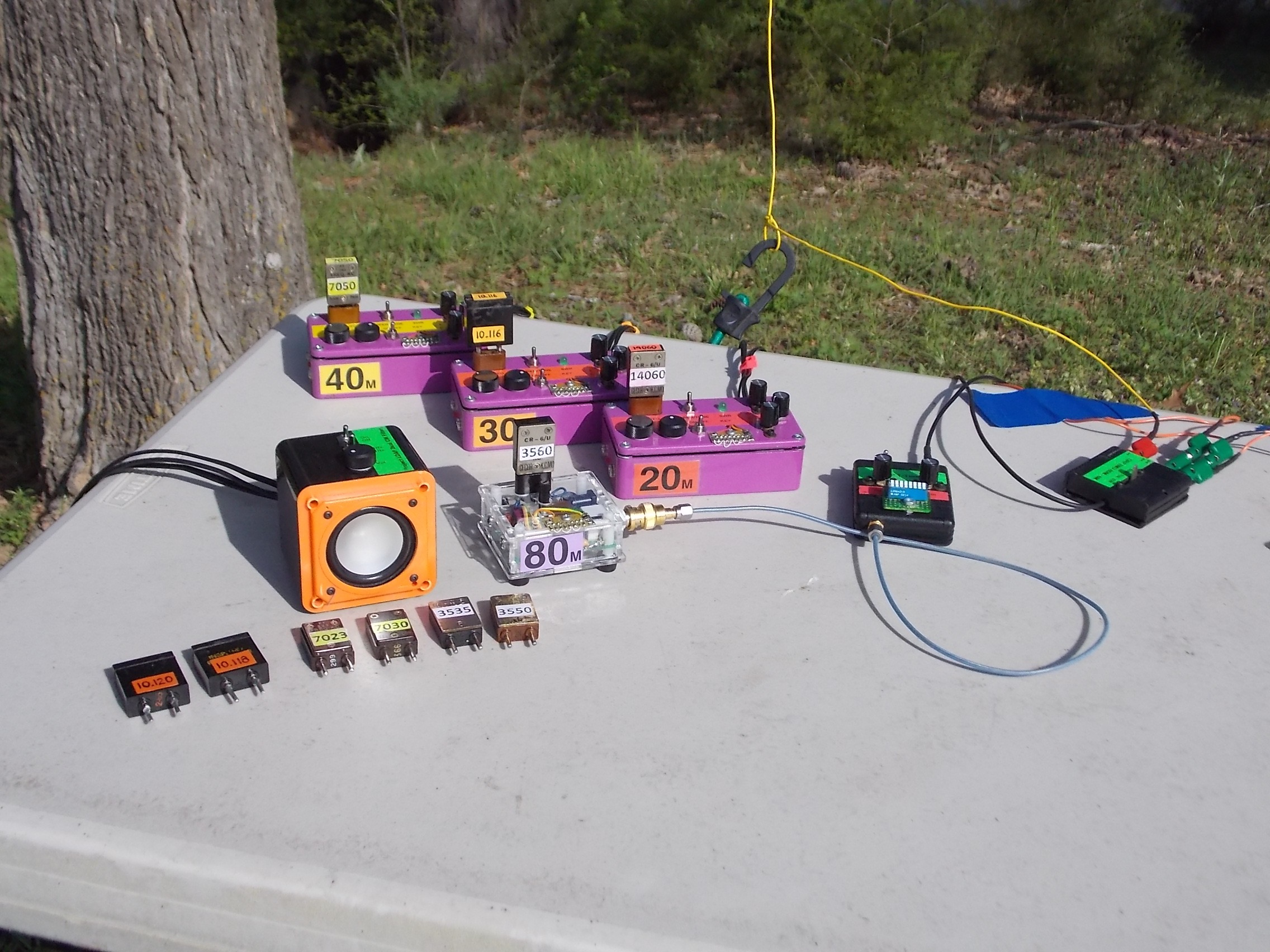
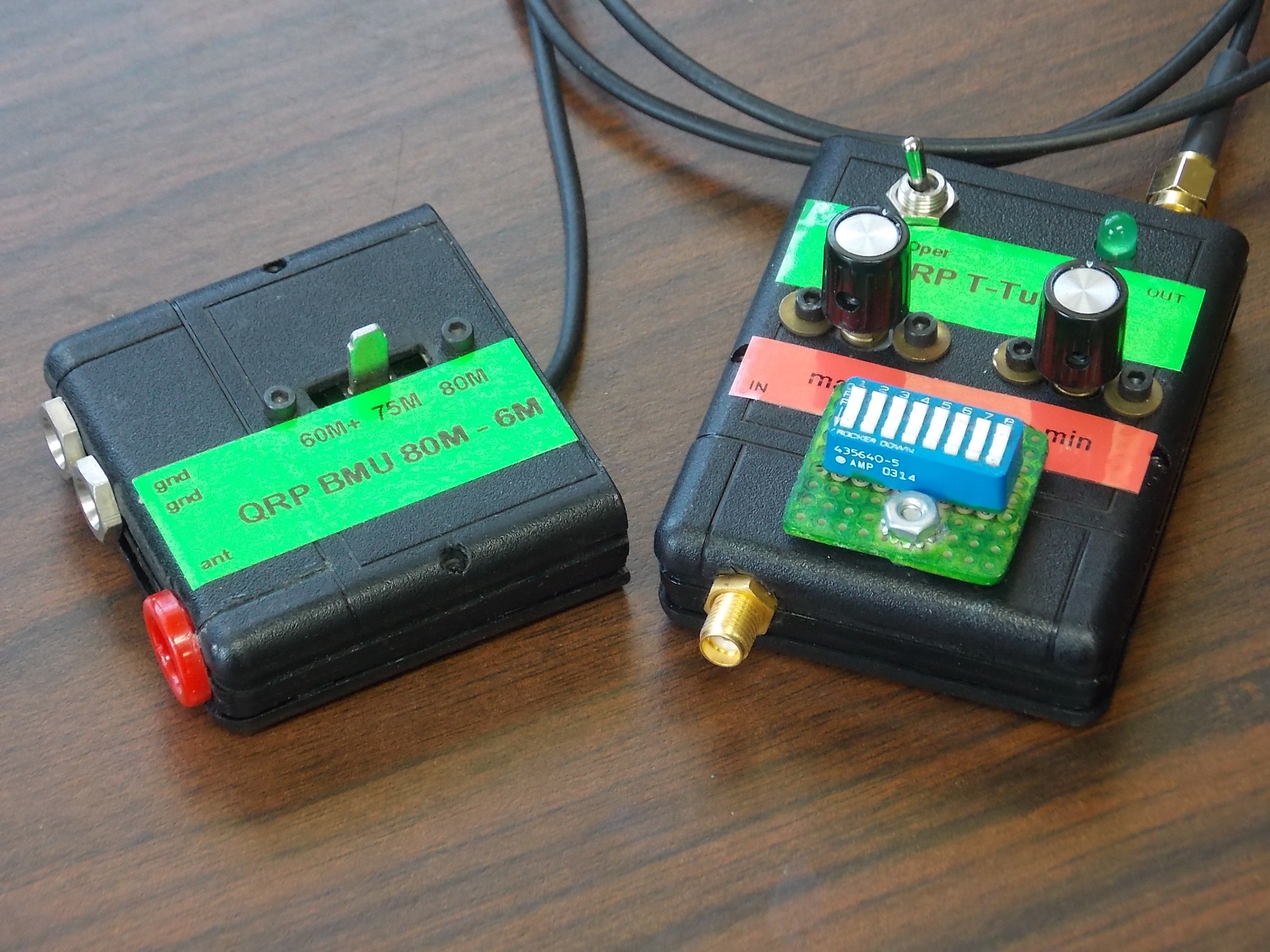

With the 6 radials, perfromance is like this, and is virtually identical to my home Inverted-L system ===> 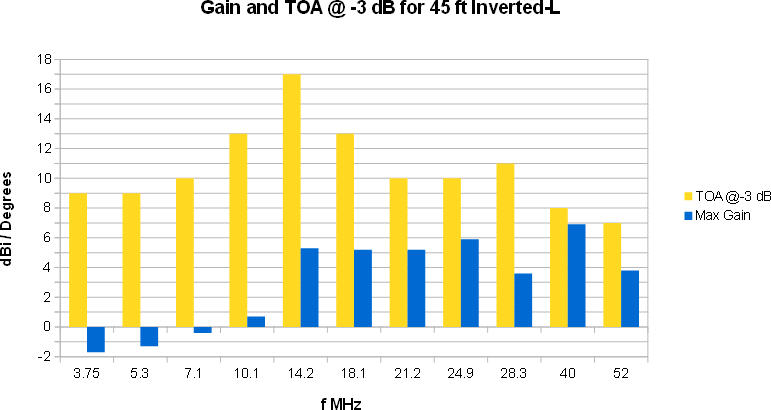
More info including Az / El Plots here "End/Base-Fed Inverted-L, 45 ft version, Elevation and Azimuth Radiation Plots" ===> http://vtenn.com/Blog/?p=110 The actual "Losses" in this system are minuscule - less than a dB in the BMU, less than a dB in the tuner, almost zero in coax. Worst "Loss" is on 80 M where the radial field could use a few more, but is still within 2 or 3 dB or so (1/2 S-Unit) off of a full size home installation. |
|
|
|
Quoted:
Its a good question about the feedline, in "theory" it should couple less than speaker wire due to improved spacing, the inactive wires shoudn't couple much IMO. View Quote |
|
|
|
Quoted:
If you're using two conductors out of a straight, untwisted 4 conductor wire as an RF transmission line, you will get significant coupling to the unused pair. Off the top of my head I wonder what would happen if you would just connect alternate wires in parallel... ie... one terminal being wires 1&3, the other terminal going to wires 2&4. Or if you only need one pair, just peel it apart and only have one pair. View Quote The norcal design uses wires 1 and 4, with 2,3 being unused. Would coupling still be an issue at qrp power levels? And we wouldn't care about coupling to the unused wires right? Just between the 2 "live" ones, or would the coupling go to the unused, then from there couple to the used wires? I'm curious since this is generally regarded as a decent antena for QRP use. doublet design |
|
|
|
Quoted:
Sorry If I wasn't clear - It's the 23 ft tall x 22 ft wide Inverted-L that i posted above. 6 x 45 ft radials on 3 wire "Baterangs" from Sota. Plus one more for the radiator wire. 80 Meters through 6 Meters. Here it is again, but this time showing the QRP version with homebrew CW transceivers, Base Matching Unit, and QRP Tuner ===> http://vtenn.com/Blog/wp-content/uploads/2016/03/FIGURE-2-45-Foot-Inverted-L-Portable-Up-In-The-Trees-3.jpg http://vtenn.com/Blog/wp-content/uploads/2016/03/FIGURE-29-Portable-Zoom-QRP-1.jpg http://vtenn.com/Blog/wp-content/uploads/2017/03/BMU-and-T-Tuner-Top-View-QRP-System.jpg http://cdn2.bigcommerce.com/server5400/qc1afpvf/products/48/images/153/WW_002__31535.1347623397.1280.1280.jpg?c=2 With the 6 radials, perfromance is like this, and is virtually identical to my home Inverted-L system ===> http://vtenn.com/Blog/wp-content/uploads/2016/03/FIGURE-6-Gain-and-TOA-45-foot-Inverted-L.jpg More info including Az / El Plots here "End/Base-Fed Inverted-L, 45 ft version, Elevation and Azimuth Radiation Plots" ===> http://vtenn.com/Blog/?p=110 The actual "Losses" in this system are minuscule - less than a dB in the BMU, less than a dB in the tuner, almost zero in coax. Worst "Loss" is on 80 M where the radial field could use a few more, but is still within 2 or 3 dB or so (1/2 S-Unit) off of a full size home installation. View Quote How are the radials setup? Does it matter? Can I use less than 6? I assume I can use an ATU with this setup and still get decent performance. I might try to pitch this up for field day, I just don't think i have enough wire for 6 radials, maybe for 4. |
|
|
|
One can trudge through those papers by N6LF about radials to figure out how much loss you're ok with for fewer radials. 4 will give another dB or 3 less signal on 80 M, but will have little effect on 60 and 40 M. The BMU is really to help matters for ATU use (and/or for long coax runs), so it should be fine.
Radials are just spaced evenly. GL - you're more ambitious than me - my setup is about 100 yds away in the back yard |
|
|
|
Quoted:
If i read that right, thats a takeoff angle of 10 degrees right? That may be important for DX, but with power in the 5W-20W range most portable operators aren't chasing DX, most are happy to get heard at short and medium distances (or at least I am, once in a while I get a DX station but its rare these days). And really if I were trying to work QRP DX, I'd find be a big empty space a few large spools of wire and some terminating resistors and build either an absurdly long beverage or V-beam/rhombic antenna for a bit more gain at really low radiation angles. Yagi like gains, extremely low take of angles. The only thing that sucks is putting them up. View Quote View All Quotes View All Quotes Quoted:
Quoted:
And then there's antenna height itself to consider... http://4.bp.blogspot.com/-VdJGfpR_s5A/UoLTNGHrL_I/AAAAAAAAAcg/gayVJJijrn4/s1600/40m_height_comparison_10deg.png Even if you manage to hoist your portable dipole 30 feet in the air, you're still many dB short of the antenna's ultimate potential. And really if I were trying to work QRP DX, I'd find be a big empty space a few large spools of wire and some terminating resistors and build either an absurdly long beverage or V-beam/rhombic antenna for a bit more gain at really low radiation angles. Yagi like gains, extremely low take of angles. The only thing that sucks is putting them up. Everything fit in my backpack to and from the beach. Usable man portable antennas are dependant on location. This would not have worked in the woods, but on the salt beach it was awesome and took 2 minutes to set up and take down. |
|
|
|
Quoted:
I took an MJF-1979 telescopic 17 foot vertical to the beach last week. I clamped an aluminium tent stake to it and pushed it into the damp sand at the ocean beach and used my CS108G+ 20 watt radio on battery power and talked to Russia, westren EU, eastern EU, and midwest US on 20 meters from the East coast of the US for an hour with NO radials because of the salt water damp sand. Everything fit in my backpack to and from the beach. Usable man portable antennas are dependant on location. This would not have worked in the woods, but on the salt beach it was awesome and took 2 minutes to set up and take down. View Quote |
|
|
 Win a FREE Membership!
Win a FREE Membership!
Sign up for the ARFCOM weekly newsletter and be entered to win a free ARFCOM membership. One new winner* is announced every week!
You will receive an email every Friday morning featuring the latest chatter from the hottest topics, breaking news surrounding legislation, as well as exclusive deals only available to ARFCOM email subscribers.
AR15.COM is the world's largest firearm community and is a gathering place for firearm enthusiasts of all types.
From hunters and military members, to competition shooters and general firearm enthusiasts, we welcome anyone who values and respects the way of the firearm.
Subscribe to our monthly Newsletter to receive firearm news, product discounts from your favorite Industry Partners, and more.
Copyright © 1996-2024 AR15.COM LLC. All Rights Reserved.
Any use of this content without express written consent is prohibited.
AR15.Com reserves the right to overwrite or replace any affiliate, commercial, or monetizable links, posted by users, with our own.

